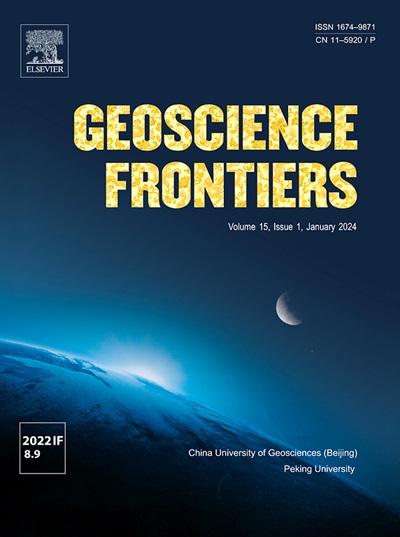典型旱地上空的气溶胶时空动态、来源分析和影响机制
IF 8.5
1区 地球科学
Q1 GEOSCIENCES, MULTIDISCIPLINARY
引用次数: 0
摘要
作为全球重要的尘源地区,旱地不仅生态系统极其脆弱,对全球气候变化异常敏感,而且对全球变暖和碳循环也有重要影响。然而,详细的旱地气溶胶特征并不清楚,尤其是对旱地气溶胶的影响机制知之甚少。本文以新疆维吾尔自治区(XJ)为研究对象,基于高空间分辨率气溶胶光学深度(AOD)数据,结合趋势分析、回溯轨迹、源解析和机器学习等方法,系统分析了XJ地区气溶胶的长期多尺度动态特征。同时,我们还定量探索了不同时间尺度下典型站点的高气溶胶源分布。此外,我们还讨论了自然和人为因素对 XJ 及其子区域气溶胶的具体影响。结果表明,从 2000 年到 2019 年,新疆 72.45%的 AOD 呈上升趋势,其中 27.56%通过了显著性检验,主要集中在北疆(NXJ)。南疆(SXJ)的AOD最大(0.240±0.154),其次是东疆(EXJ)(0.157±0.038),北疆(NXJ)的AOD最小(0.134±0.028);但北疆(NXJ)的AOD上升趋势最明显,在2011年达到峰值,而XJ的AOD在海拔5000米及以上保持低位稳定。后向轨迹显示,SXJ地区近一半的高AOD潜在路径来自塔克拉玛干沙漠,NXJ地区的大部分潜在路径来自跨界传输,主要通过裸露的湖床,EXJ地区的大部分潜在路径来自西北部,其特征与NXJ相似。裸露的湖床提供了盐尘,进一步加剧了 NXJ 和 EXJ 地区气溶胶的复杂性和危害性。SXJ 的 AOD 潜在源区集中在目标地点的东北部,NXJ 的 AOD 潜在源区集中在目标地点的西部,EXJ 的 AOD 潜在源区集中在西北部和东部。SXJ(63.92%)和 EXJ(74.83%)或 XJ(57.77%)的 AOD 主要由自然因素造成,而 NXJ 的 AOD(84.01%)则主要由人为因素造成。本文章由计算机程序翻译,如有差异,请以英文原文为准。

Aerosol spatiotemporal dynamics, source analysis and influence mechanisms over typical drylands
As globally important dust source areas, drylands not only have extremely fragile ecosystems that are exceptionally sensitive to global climate change but also have important implications for global warming and carbon cycling. However, the detailed dryland aerosol characteristics are not clear, especially the influence mechanisms of dryland aerosols, which are poorly understood. In this paper, Utilizing the Xinjiang Uygur Autonomous Region (XJ) as a target area, based on high spatial resolution aerosol optical depth (AOD) data, combined with the trend analysis, backward trajectory, source analysis, and machine learning methods, we systematically analyzed the multiscale dynamic characteristics of aerosols in XJ over a long period. Simultaneously, we also quantitatively explored the source distributions of high aerosols at typical sites at different time scales. Furthermore, we discussed the specific effects of natural and anthropogenic factors on aerosols in XJ and its subregions. The results show that 72.45% of the AOD in XJ presents an increasing trend from 2000 to 2019, 27.56% of which passed the significance test, mainly concentrated in northern Xinjiang (NXJ). The AOD in southern Xinjiang (SXJ) is the largest (0.240 ± 0.154), followed by eastern Xinjiang (EXJ) (0.157 ± 0.038), and the AOD in NXJ is the smallest (0.134 ± 0.028); however, the AOD in NXJ has the most obvious increasing trend, peaking in 2011, and the AOD in XJ remains low and stable at 5000 m elevation and above. The backward trajectory shows that nearly half of the potential paths of high AOD in SXJ are from the Taklamakan Desert, most of the potential paths in NXJ are from transboundary transmission, mostly through exposed lake beds, and most of the potential paths in EXJ are from the northwest, with characteristics similar to those of NXJ. The exposed lake beds provide salt dust, which further exacerbates the complexity and hazards of aerosols in NXJ and EXJ. The potential source areas for AOD in SXJ are concentrated in the northeast of the target site, those in NXJ are concentrated in the west of the target site, and those in EXJ are in the northwest and east. The AOD in SXJ (63.92%) and EXJ (74.83%) or XJ (57.77%) is dominated by natural factors, whereas the magnitude of AOD in NXJ (84.01%) is largely explained by anthropogenic factors.
求助全文
通过发布文献求助,成功后即可免费获取论文全文。
去求助
来源期刊

Geoscience frontiers
Earth and Planetary Sciences-General Earth and Planetary Sciences
CiteScore
17.80
自引率
3.40%
发文量
147
审稿时长
35 days
期刊介绍:
Geoscience Frontiers (GSF) is the Journal of China University of Geosciences (Beijing) and Peking University. It publishes peer-reviewed research articles and reviews in interdisciplinary fields of Earth and Planetary Sciences. GSF covers various research areas including petrology and geochemistry, lithospheric architecture and mantle dynamics, global tectonics, economic geology and fuel exploration, geophysics, stratigraphy and paleontology, environmental and engineering geology, astrogeology, and the nexus of resources-energy-emissions-climate under Sustainable Development Goals. The journal aims to bridge innovative, provocative, and challenging concepts and models in these fields, providing insights on correlations and evolution.
 求助内容:
求助内容: 应助结果提醒方式:
应助结果提醒方式:


